Beverly Scott's Blog, page 12
June 14, 2016
In Honor of My Father, by Bev Scott
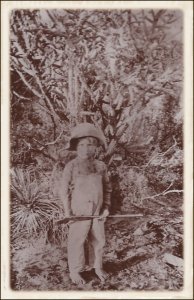
Henry Clay Scott, 2 years old
I share these memories of my father, Henry Clay Scott, who died almost 50 years ago. I am also very aware of him and his life since I am writing a novel inspired by the lives of his parents and their children, “Trust, Betrayal and Forgiveness.”
A white-out blizzard roared on the prairie plunging the temperature to below zero. Clay, as he was called, put the last piece of wood in the wood burning stove. Although he was a young boy, he saw himself as “the man of the house”. He prepared to bundle up to go to the barn to look for some other fuel to burn.
His mother, crippled from rheumatoid arthritis stopped him. “I can’t let you go out in this storm. With the white-out, you could get disoriented, lose your way and freeze to death. Let’s wait and see if it lets up.”.
But the blizzard didn’t let up and the white-out thickened. The temperature in their small two-room house dropped without any heat. The outside temperature plummeted to an estimated thirty below zero and the wind howled and blustered through the cracks. My father, his sister and mother were bundled in several layers of clothes and wrapped in blankets but it was not enough.
My grandmother came to a difficult decision. She believed it was the only choice she had to save them all from freezing to death. They burned her books to stay warm. This must have been a painful decision for a woman who was a school teacher and highly valued education.
This is just one of the stories I heard about the sacrifice, deprivation and poverty that shadowed my father in his childhood. Clay was the fourth son of Ellen and Harvey Depew (HD) Scott, born in 1907 in Dewey County, Oklahoma. H.D. was thirty years older than Ellen and died in 1911 leaving her with five children including an infant girl born just months before.
Before his father died, Clay had rheumatic fever. He had barely survived and was so weak he couldn’t stand or walk. His older brothers doted on him and carried him everywhere. Their fondness for my father was evident to me when I was growing up even though I knew nothing about this childhood experience.
The older brothers left home early to work and begin their own families. My father and his younger sister worked too, scrimped and saved, and ultimately managed to get college educations. My grandmother had given to my father her love of learning and belief in the value of education. I knew when I was as young as four years old, that I too would go to college one day. A nickel from my fifteen cent allowance was required to go into my college fund.
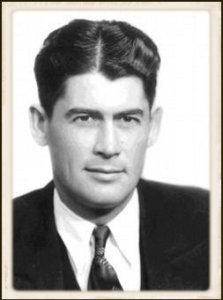
Henry Clay Scott, as a young man
My father was a terrific role model always reading and learning. He saved articles for me to read, taught me the Latin names of plants when I was five and always answered my questions with another question or “What do you think?” He believed in respecting and accepting all people. He taught me, “You don’t have to like what someone does, but you must respect who they are as a human being.”
Clay was frugal but not stingy. He and my mother taught me to appreciate and be grateful for my life and to give back as generously as I could. The poverty and sacrifice of his early life influenced his actions throughout his life. He didn’t like waste. He was sure to get the last drop, eat the last crust of bread or chew every shred of chicken off the bones. He was friendly and humble with a delightful sense of humor. He was very handsome with black wavy hair. When he was courting my blond, blue-eyed mother, her friends called him the “dark prince.”
After I graduated from high school, he suffered from heart disease. He sold his business and went back to school to get a Master’s degree to teach. He died in 1967 at the young age of sixty. He was teaching college students to appreciate the amazing wonders of the natural world just as he did for me as a little girl.
His love and guidance will always be with me. And, I miss him. Happy Father’s Day!
What are your memories of your father?
June 8, 2016
Book Review: “The Girl from Krakow” by Alex Rosenberg
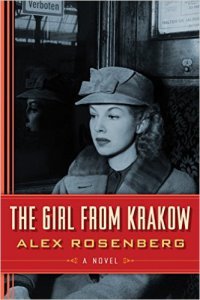 This is a story of passion, maternal instincts and subterfuge during World War II in Poland. Rita, a young Jewish woman searching for a more exciting life is studying law in Krakow when she meets Urs in his last year of medical school. Despite her initial resistance, she marries him but finds his stiff and routine approach to sex unsatisfying to her. She meets and launches what later becomes a passionate affair with Dr. Tadeusz, the second main protagonist, who is deceptive with a tendency to delude and fabricate stories to meet his own needs. When Rita’s husband discovers their weekly trysts under the guise of infertility treatments, he attempts suicide. The affair is ended and Rita reconciles with Urs to maintain appearances. When she discovers she is indeed pregnant, he is relieved as he counts back and realizes the child is his.
This is a story of passion, maternal instincts and subterfuge during World War II in Poland. Rita, a young Jewish woman searching for a more exciting life is studying law in Krakow when she meets Urs in his last year of medical school. Despite her initial resistance, she marries him but finds his stiff and routine approach to sex unsatisfying to her. She meets and launches what later becomes a passionate affair with Dr. Tadeusz, the second main protagonist, who is deceptive with a tendency to delude and fabricate stories to meet his own needs. When Rita’s husband discovers their weekly trysts under the guise of infertility treatments, he attempts suicide. The affair is ended and Rita reconciles with Urs to maintain appearances. When she discovers she is indeed pregnant, he is relieved as he counts back and realizes the child is his.
Germany has put an end to Poland, controlling the east while the Soviets have marched into the west. Urs now working for a Soviet government clinic is soon ordered to leave for conscription in the Soviet army. Rita and her young son are left behind. She rents out a room to Eric, a young man she finds interesting and attractive . A work permit at a factory allows him connections to help get Rita’s son sent with a Polish resistance courier to deliver her son to her parents. Unfortunately, when she learns that the courier is arrested by the Nazis, it is doubtful her son was delivered to her parents. But she never gives up believing that he somehow survives. Eric’s connection allows her to obtain false identity papers and escape to Warsaw to begin looking for her son. With German looks, ability to speak flawless German as well as Polish and her daring courage, she takes many chances in her search for him. Meanwhile, we learn that the disingenuous Dr. Romero with his Spanish disguise is hiding out in Moscow, taking risks of his own.
The well-researched historical context of this book offers the opportunity for an engaging story about the personal pain and emotional challenges brought by the brutality of the Nazi invasion of Poland. However, some aspects of the book are confusing or distracting such as the story flipping between the setting for two main protagonists Rita and Dr. Romero. I was also troubled by a lack of character development for Dr. Romero and I questioned the believability of Rita’s character especially her risky sexual behavior. Despite these concerns, I enjoyed the book and found the story engrossing.
Book Review: The Girl from Krakow, by Alex Rosenberg
 This is a story of passion, maternal instincts and subterfuge during World War II in Poland. Rita, a young Jewish woman searching for a more exciting life is studying law in Krakow when she meets Urs in his last year of medical school. Despite her initial resistance, she marries him but finds his stiff and routine approach to sex unsatisfying to her. She meets and launches what later becomes a passionate affair with Dr. Tadeusz, the second main protagonist, who is deceptive with a tendency to delude and fabricate stories to meet his own needs. When Rita’s husband discovers their weekly trysts under the guise of infertility treatments, he attempts suicide. The affair is ended and Rita reconciles with Urs to maintain appearances. When she discovers she is indeed pregnant, he is relieved as he counts back and realizes the child is his.
This is a story of passion, maternal instincts and subterfuge during World War II in Poland. Rita, a young Jewish woman searching for a more exciting life is studying law in Krakow when she meets Urs in his last year of medical school. Despite her initial resistance, she marries him but finds his stiff and routine approach to sex unsatisfying to her. She meets and launches what later becomes a passionate affair with Dr. Tadeusz, the second main protagonist, who is deceptive with a tendency to delude and fabricate stories to meet his own needs. When Rita’s husband discovers their weekly trysts under the guise of infertility treatments, he attempts suicide. The affair is ended and Rita reconciles with Urs to maintain appearances. When she discovers she is indeed pregnant, he is relieved as he counts back and realizes the child is his.
Germany has put an end to Poland, controlling the east while the Soviets have marched into the west. Urs now working for a Soviet government clinic is soon ordered to leave for conscription in the Soviet army. Rita and her young son are left behind. She rents out a room to Eric, a young man she finds interesting and attractive . A work permit at a factory allows him connections to help get Rita’s son sent with a Polish resistance courier to deliver her son to her parents. Unfortunately, when she learns that the courier is arrested by the Nazis, it is doubtful her son was delivered to her parents. But she never gives up believing that he somehow survives. Eric’s connection allows her to obtain false identity papers and escape to Warsaw to begin looking for her son. With German looks, ability to speak flawless German as well as Polish and her daring courage, she takes many chances in her search for him. Meanwhile, we learn that the disingenuous Dr. Romero with his Spanish disguise is hiding out in Moscow, taking risks of his own.
The well-researched historical context of this book offers the opportunity for an engaging story about the personal pain and emotional challenges brought by the brutality of the Nazi invasion of Poland. However, some aspects of the book are confusing or distracting such as the story flipping between the setting for two main protagonists Rita and Dr. Romero. I was also troubled by a lack of character development for Dr. Romero and I questioned the believability of Rita’s character especially her risky sexual behavior. Despite these concerns, I enjoyed the book and found the story engrossing.
June 1, 2016
Self-Promotion, Writing and Social Media, by Bev Scott
“I want to write. The last thing I want to do is market my book!”
My own feelings about marketing were similar when I got serious about writing a novel inspired by my grandparents. In fact, I frequently had avoided marketing during my former consulting career. Self-promotion does not come easily for many of us who are consultants or writers.
But, in 2014 I attended the San Francisco Writer’s Conference. I realized how naïve those words are for a writer who wants to publish in today’s topsy-turvy market. I also better understood why the second edition of my non-fiction book, published by a trade press, had not been promoted by the publisher as heavily as the first edition.
Writer’s Platform
What I learned at that Conference and in subsequent writing conferences and workshops, is that writers must market and promote their own work if they want to sell their books. Writers need a “platform” composed of friends, colleagues and contacts who “like” or follow them. To build that platform, writers must join two or more social media platforms such as Facebook, Twitter, Linked-In, Pinterest, Instagram, Google + or Goodreads. They must also build a website and send out blogs.
Yes, you are right. Building a platform takes time. Frances Caballo, who has specialized and written books about social media for writers, declares that authors need to spend only thirty minutes a day posting on social media. However, I have found that it takes a much larger time investment to learn the rules and practices of the specific platform, craft my profile and get comfortable in using it. The effort to reach followers and build a platform must not be too flagrant, too frequent or too frustrating to your “followers”. But what does that mean?
It means an author/writer should spend about 80 percent of her communication with her “followers” giving interesting tidbits, advice, suggestions, information and links that her readers might like or enjoy. The other 20 percent of her communication on social media, she can write some tasteful self-promotion of her work.
Thirty Minutes? Really?
Building a platform takes time from writing her book. It means spending time writing a blog or finding content to post or link on social media. It is time figuring out why the photo she wanted to post turned sideways. It means spending some of those thirty minutes commenting and engaging with her followers. And, there is no guarantee that engaging in all this social media will actually build a platform of followers interested in her writing. There is only hope.
Another recommendation from the Writer’s Conference was to begin building the writer’s platform long before the book is due to be released…Two years? At least one. And the six months before publication when she is busy doing final edits, choosing a cover design and finalizing a publisher, she must really step up building that platform.
Publishing in Six Months
I am hoping to publish this year, in the next six months. So, I am stepping up my social media efforts. And I want to spend some of the twenty percent of my communication with you to boldly ask you to: Like my Facebook page; sign up on my website to receive updates about my book in your in-box; share my postings on your own social media; and tell your friends.
Thank you!
May 25, 2016
Turning on Your Creative Brain, by Bev Scott
Our brain is complicated. It is not as simple as right brain and left brain. Neuroscience has studied what part of our brain lights up when we exercise our organizational/executive functions.
This author argues that we should pay attention to when it does not light up, for example when we daydream or relax. For creative thinking, we need some time when we shut down our organization and executive thinking such as in the shower where many of us have experienced our most creative thinking.
As a writer, I am acutely aware of how important it is to turn off the chatter in my brain about dates, tasks and emails. I find I do some of my most creative time is when I first wake up in the morning. My mind is unfocused, unorganized and empty.
This article also offers some tips to help us be more creative in any work we are doing. What are you doing to support your creativity?
Turning on Your Creative Brain
May 17, 2016
My Grandfather, a Cowboy? by Bev Scott
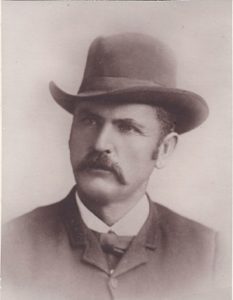 My paternal grandfather was an absent figure when I was growing up. He wasn’t just absent; he didn’t exist. My father didn’t know anything about him; my grandmother just dismissed any questions by changing the subject. So, I assumed he didn’t exist.
My paternal grandfather was an absent figure when I was growing up. He wasn’t just absent; he didn’t exist. My father didn’t know anything about him; my grandmother just dismissed any questions by changing the subject. So, I assumed he didn’t exist.
During a trip to Washington DC, I visited the National Archives and uncovered the family secret that had humiliated my grandmother and been hidden from the rest of our family. I have written in previous blogs about the resulting genealogical journey to document H. D. Scott’s life. Unable to find all the details of the story, especially what happened to him between the time he abandoned his first family and married my grandmother, I decided to fictionalize the story.
Creating Sam
I have created the fictional character, Sam, in my story based on two clues about H.D.’s life between 1878 and 1891. He “worked cattle” with an “outfit from Dodge City, Kansas”. Sam escapes the Texas Rangers by becoming a cowboy and joining a cattle drive going north to Dodge City. The years 1878-1879 are the peak of the cattle drives in the midst of the cowboy era.
Developing Sam’s character in some ways was easier because I had no preconception of my grandfather. I knew he was thirty years older than my grandmother, but I didn’t find out if he was tough, distant and cold or warm, affectionate and funny. But, as a child, I knew my grandmother. What man would she have married? I wrestled with the contradictions of my image of the man she would marry and the facts I had uncovered. My image of a man who abandoned his pregnant wife and five children didn’t seem like the kind of person she would choose to marry.
Cowboys
Given the era, the location and the clues, I had uncovered, I began to explore and learn about cowboys as a possible 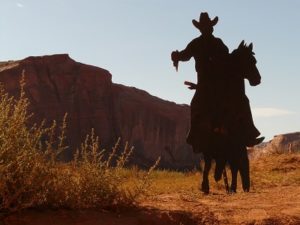 model for my grandfather. Today, we identify the cowboy with the West and the time of the cattle drives. However, history tells us that men worked cattle in Massachusetts, Florida, Alabama, Georgia. But it was the men, one-fourth of whom were black, driving the longhorn cattle from Texas north, who became the folklore heroes we think of as cowboys. They spent long dusty days driving thousands of cattle across empty plains for hundred’s of miles. It was a dangerous life. They faced animals who were easily startled into a stampede, drought, lightning and thunderstorms, rattlesnakes, Indians, and outlaws. They ate grub from the cook wagon, slept on the ground and lived a lonely, spare existence.
model for my grandfather. Today, we identify the cowboy with the West and the time of the cattle drives. However, history tells us that men worked cattle in Massachusetts, Florida, Alabama, Georgia. But it was the men, one-fourth of whom were black, driving the longhorn cattle from Texas north, who became the folklore heroes we think of as cowboys. They spent long dusty days driving thousands of cattle across empty plains for hundred’s of miles. It was a dangerous life. They faced animals who were easily startled into a stampede, drought, lightning and thunderstorms, rattlesnakes, Indians, and outlaws. They ate grub from the cook wagon, slept on the ground and lived a lonely, spare existence.
Cowboys as folk heroes can be handsome, mysterious, courageous and charismatic. In fact, we have hundreds of stories in novels, movies, radio, and television that have charmed and fascinated us. Consider Roy Rogers, Gene Autry, the Lone Ranger or Gunsmoke’s Matt Dillon among many other cowboy personalities. The lore and lure of the Western way of life draw many “dudes” today to wear Western wear, reserve weeks at guest ranches in Wyoming, Colorado, and Montana and attend rodeo’s, and Wild West shows displaying the skill and fearlessness of the cowboy.
As a person who I grew up in Montana with a family who live today’s Western way of life in Wyoming and Colorado, it was easy for me to imagine my character, Sam as a cowboy…Handsome, charming, independent, mysterious and attractive to my grandmother.
I have been engaged and challenged as I created Sam’s character. I am excited to be nearing the end with the hope of publishing the story this year.
Do you have cowboy heroes or favorite books or programs? What is your image of a cowboy?
Does Western lore bore you or lure you?
May 10, 2016
Book Review: Behind Palace Walls, by Erin Chase
Reviewed by Bev Scott
Sheshamun, the adopted daughter of peasants, unexpectedly finds herself recommended to the Pharaoh’s harem. Finding life in the harem unlike her dream of living a royal life, and forbidden to see her parents, she escapes from the palace. Of course she is found and brought back to be sentenced by the Pharaoh to a slave camp, escaping a death sentence with the intervention of the Royal Wife. This experience provides the opportunity for Sheshamun to mature, gain confidence in herself and find support from the friends she makes. Sheshamun’s story kept me engaged as the author provides mystery, suspense and romance through the historical lens of ancient Egypt.
I have long enjoyed fiction about ancient Egypt and this was no exception. In contrast to other authors, Erin Chase provides us a glimpse not only into the luxuries of royal living but we also see the humble life of peasants and the spare existence of those condemned to the slave camp. It is a long book, however. I would encourage the author to reduce the length, as well as more closely follow advice offered by C.J. Lakin in her blog “Live, Write, Thrive”. Reduce the narrative description which is not necessary to move the story forward.
May 3, 2016
Dodge City: The Wickedest Little City in the West By Bev Scott
A letter in the Washington D.C.’s Evening Star of January 1, 1878, stated,
“Dodge City is a wicked little town. Indeed, its character is so clearly and egregiously bad that one might conclude, were the evidence in the later times positive of its possibility, that it was marked for special Providential punishment” (quoted in Legends in America).
As a young girl growing up in Montana, I remember listening to Gunsmoke on the radio with my family. Television arrived with one channel when I was in the eighth grade, but my parents didn’t see any use for it. Since it was one of my favorite programs, I incorporated some phrases into my repertoire like, “…get out of Dodge!” Little did I expect that I would be researching the history of Dodge City and learning many of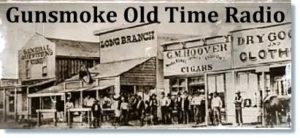 the true stories on which Gunsmoke was based decades later.
the true stories on which Gunsmoke was based decades later.
Dodge City was known as “The Wickedest Little City in the West” from its reputation of lawlessness and gunfights. It is associated with such famous gunslingers as Wyatt Earp, Doc Holliday, and Bat Masterson. In my last blog, I talked about the missing information about my grandfather between 1879 and 1891, but I had two clues that he worked cattle, perhaps as a cook, with an outfit from Dodge City. I researched and even visited this historic town as background for my writing.
Early History of Dodge City
The early history of Dodge City begins in 1872, according to William Shillingberg who wrote Dodge City: The Early Years, 1872-1886, with a saloon and a general store established a five miles West of Fort Dodge. Following the establishment of the first businesses, the railroad arrived in short order. Soon Dodge City became a wide-open railroad town with stacks of buffalo [image error]hides lining the street. Over one and a half million of them were shipped out. According to legend, the train masters took their red caboose lanterns with them to visit the prostitutes in town launching the term “red light district.
Dodge City initially had no law enforcement. The dance halls and saloons, as well as the lawless atmosphere, attracted buffalo hunters, railroad men, and soldiers after long stints on the prairie. Inevitably, fights occurred and many a gunfighter died and was buried with his boots on in Boot Hill. By 1876, the buffalo had been killed off, and the buffalo hunters were out of business. Longhorn cattle drove business back to Dodge City. In a ten-year period, over 5 million cattle were shipped out of Dodge City. The cowboys who came with the cattle brought, even more, lawlessness, spreading Dodge City’s reputation as far as Washington, D.C.
Controlling the Lawlessness
The wild lawlessness prompted the mayor to request such a well-known gunman as Wyatt Earp for help. Soon Earp was joined by Bat Masterson, Bill Tilghman, and Charlie Bassett as assistant deputies. Marshal Matt Dillon in the Gunsmoke episodes was modeled a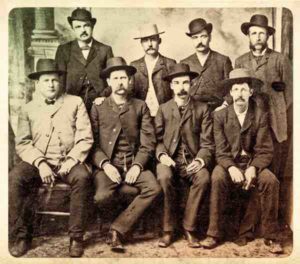 fter these lawmen in Dodge City.
fter these lawmen in Dodge City.
The first effort at controlling the lawlessness was an ordinance which established a “Deadline” where the railroad tracks ran through Dodge. On the North side, in the commercial side of town, no gun toting was allowed. However, so many were arrested for carrying their weapons, that the jails were filled. South of the tracks, anything went. Guns were allowed, and lawlessness and gunfights persisted in the taverns and brothels. By 1876 the town had grown to 1200 with nineteen businesses licensed to sell liquor.
Doc Holliday, another famous gunslinger, associated with Dodge City, arrived in 1878 with a woman posing as his wife called Big Nose Kate Elder. Although he occasionally provided professional services to town residents, he mostly drank and gambled at the Long Branch Saloon. Doc Holliday was considered one of the deadliest shooters of the West, but he followed the law while in Dodge City.
Experiencing Dodge City in My Story
The character in my story, Will, arrives in Dodge City with the cattle drive in 1878 excited to be in the famous town and wondering if he’ll meet Wyatt Earp or Bat Masterson. After loading cattle at the railyard, Will, and his two companions, Jake and Tom head to the Long Branch Saloon where Will spots a gunslinger or bounty hunter. Jake, the boss of the cattle drive, approaches him to find out why he is watching the crew.
Will heard Jake say, “Lookin’ for someone? That’s my crew you’re watchin’.” Jake jerked his thumb toward the wranglers at the billiard table. But Will couldn’t hear the stranger’s reply.
His mouth went dry and his gut clenched worried that this gunslinger was after him. When Jake rejoined Tom and Will at the other end of the bar, Will had moved into the shadows to be less conspicuous. He wanted to be near the back door so he could make a quick escape.
His heart raced as Jake relayed the conversation. “He’s looking for a gambler dressed as a hayseed. Had a gunfight and killed some upstanding citizen in Fort Worth. Reported to have joined a cattle drive. This tough cowboy is looking over our crew. Looking for a ‘Will Martin’. Wants to take him in for the money.”
As he spoke, Will held his breath but his heart was pounding. He slowly slunk toward the back door. Jake looked directly at Will and with a firm voice over the noise in the Tavern said, “I told him we had no Will Martin on our crew.”
Suddenly, Will felt a gun barrel in his ribs. (From unpublished manuscript, Trust, Betrayal and Forgiveness: A Family Story)
Did you listen or watch “Gunsmoke” when you were growing up? Do you have images of Dodge City as wicked, lawless town? Did you like cowboy and Western movies? Have you heard other stories of this famous time in our history?
April 18, 2016
How to Avoid Being Crushed in a Stampede, by Bev Scott
This post is the first in a series about the era of the cattle drive from Texas to Dodge City, Kansas.
“Ride! Ride like the devil! Ride for your life, man! Stick spur in your pony’s flank, and press hard and press long; lean low over your saddle bow—speak quick, sharp words of encouragement and command to your beast, and ride for your life! For behind you, like the waves of a mad sea, are ten thousand frightened steers, and you are scarce the length of your horse ahead of them! If your pony stumbles….if anything happens by which his speed is checked…the hoofs that are thundering at your heels shall tramp every semblance of humanity out of your body before you can utter a prayer or curse!” (quoted in “The Western: The Greatest Cattle Trail 1874-1886 by Kraisinger and Kraisinger)
Grandfather disappeared
My grandfather not only disappeared from his family in Weatherford, Texas after he took a load of corn to town in 1879, he also disappeared from the official records. I could find no information in the 1880 census nor any other official record until he shows up filing a homestead claim in Glendo. Wyoming in 1891. What was he doing in those missing years?
I never imagined my grandfather, H.D. Scott, involved in the famous longhorn cattle drives from Texas to Dodge City, Kansas. But, I found two clues in the National Archive documents: H.D., himself, claimed he worked cattle during that time and one of the government agents reported that he served as “a cook on an overland expedition” for an outfit from Dodge City.
Texas Cattle Drives
 As a result of these clues I began to explore the Texas cattle drives that began in the late 1860’s on the famous Chisholm Trail. At the time it was the only trail through Indian Territory to Kansas. Later, between 1874 and 1886, cattle were driven up the much longer Western Trail not only to Kansas but also up to Ogallala, Nebraska, Wyoming and Montana according to The Western: The Greatest Cattle Trail, 1874-1886 by Gary and Margaret Kraisinger. The cattle shipped from the Western Trail on rail cars headed east are reported to be over five million cattle!
As a result of these clues I began to explore the Texas cattle drives that began in the late 1860’s on the famous Chisholm Trail. At the time it was the only trail through Indian Territory to Kansas. Later, between 1874 and 1886, cattle were driven up the much longer Western Trail not only to Kansas but also up to Ogallala, Nebraska, Wyoming and Montana according to The Western: The Greatest Cattle Trail, 1874-1886 by Gary and Margaret Kraisinger. The cattle shipped from the Western Trail on rail cars headed east are reported to be over five million cattle!
TV, movies and novels have glorified the Texas cattle drive and the Cowboys that served as drovers. Life on the trail was not very glamorous. Cowboys slept on the ground and ate monotonous food. They coped with blistering sun, thunderstorms, floods and Indians. It was lonely, and at the time very dangerous.
Wild Longhorn Cattle
The Longhorn was a defensive and skittish animal descended through natural selection on the range from Spanish and Anglo-American cattle. These animals were wild, with long powerful legs and hard hoofs, capable of surviving long drives with minimal grazing feed. The Kraisingers report that they could do “a several-hundred-mile trek and …still gain weight.” But any sudden noise such as thunder and lightning, or strange event, lighting a match or the sound of a tin cup, could cause a frantic stampede such as described above. The consequences could be gruesome:
“We went back to look for him, and we found him among the prairie dog holes, beside his horse. The horse’s ribs were scraped bare of hide and all the rest of horse and man was mashed into the ground as flat as a pancake. The only thing you could recognize was the handle of his six-shooter. We tried to think the lightning hit him, and that was what we wrote his folks…But we couldn’t really believe it ourselves…I’m afraid his horse stepped into one of them holes and they both went down before the stampede.” (quoted in Kraisinger and Kraisinger)
The drover’s job was to get the terrified animals under control by riding his mount 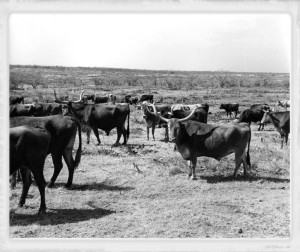 abreast of the lead steer to turn them to run in a circle. The circle could be miles wide but gradually as the cattle were exhausted they would mill in a circle and quiet down. Rivers had to be crossed even in at flood stage. There was a right way to negotiate a river that took the time of day, and outside influences into account. Cattle, horses, and men could lose their lives in a fast-moving river.
abreast of the lead steer to turn them to run in a circle. The circle could be miles wide but gradually as the cattle were exhausted they would mill in a circle and quiet down. Rivers had to be crossed even in at flood stage. There was a right way to negotiate a river that took the time of day, and outside influences into account. Cattle, horses, and men could lose their lives in a fast-moving river.
The wave of homesteaders moving into former Indian Territories and the advent of barbed wire brought the era of Longhorn cattle drives to a close by 1886. But during a short period of time, savvy organizers and contractors could make a fortune. Some report over $100,000 according to Harry Drago! However, there was always a risk of losing upwards of 1500 head of cattle in a herd of 3000. The drovers didn’t get rich. They might receive $30.00 a month with $100 for the trail boss. Some of them, though, did parlay their opportunity into becoming land owners with a herd of cattle.
Creating the Story
Once I determined that I would write my family story as fiction, the clues in the Archive documents lead me to explore this history and the stories of the cattle drives. I have found both challenge and enjoyment in creating the story of my character’s experience as a cook on a Texas cattle drive. Here’s a short excerpt from his second day on the drive:
He enjoyed the camaraderie on this crew. It reminded him of his time in the Union Army–sleeping on the ground, boring food, dirty, no women or home comforts. A hard life. But it was eased by the easy-going company of men joking with each other, telling stories or singing around the campfire. Being here was like putting on old boots that have molded to your feet. He didn’t need to worry about these men learning his secret. Cowboys minded their own business. He was sure their pasts weren’t pure and no one asked any questions, including Jake (From Trust, Betrayal, and Forgiveness: A Family Story).
Imagine My Grandfather as a Texas Cowboy! by Bev Scott
This is the first in a series about the era of the cattle drive from Texas to Dodge City, Kansas.
“Ride! Ride like the devil! Ride for your life, man! Stick spur in your pony’s flank, and press hard and press long; lean low over your saddle bow—speak quick, sharp words of encouragement and command to your beast, and ride for your life! For behind you, like the waves of a mad sea, are ten thousand frightened steers and you are scarce the length of your horse ahead of them! If your pony stumbles….if anything happens by which his speed is checked…the hoofs that are thundering at your heels shall tramp every semblance of humanity out of your body before you can utter a prayer or curse!” (quoted in “The Western: The Greatest Cattle Trail 1874-1886 by Kraisinger and Kraisinger)[image error]
Grandfather disappeared
My grandfather not only disappeared from his family in Weatherford, Texas after he took a load of corn to town in 1879, he also disappeared from the official records. I could find no information in the 1880 census nor any other official record until he shows up filing a homestead claim in Glendo, Wyoming in 1891. What was he doing in that eleven-to-twelve-year’s time?
I never imagined my grandfather, H.D. Scott, involved in the famous longhorn cattle drives from Texas to Dodge City, Kansas. But, I found two clues in the National Archive documents: H.D., himself, claimed he worked cattle during that time and one of the government agents reported that he served as “a cook on an overland expedition” for an outfit from Dodge City.
Texas Cattle Drives
 As a result of these clues I began to explore the Texas cattle drives that began in the late 1860’s on the famous Chisholm Trail. At the time it was the only trail through Indian Territory to Kansas. Later, between 1874 and 1886, cattle were driven up the much longer Western Trail not only to Kansas but also up to Ogallala, Nebraska, Wyoming and Montana according to The Western: The Greatest Cattle Trail, 1874-1886 by Gary and Margaret Kraisinger. The cattle shipped from the Western Trail on rail cars headed east are reported to be over five million cattle!
As a result of these clues I began to explore the Texas cattle drives that began in the late 1860’s on the famous Chisholm Trail. At the time it was the only trail through Indian Territory to Kansas. Later, between 1874 and 1886, cattle were driven up the much longer Western Trail not only to Kansas but also up to Ogallala, Nebraska, Wyoming and Montana according to The Western: The Greatest Cattle Trail, 1874-1886 by Gary and Margaret Kraisinger. The cattle shipped from the Western Trail on rail cars headed east are reported to be over five million cattle!
Although TV, movies and novels have glorified the Texas cattle drive and the cowboys that served as drovers, life on the trail was not very glamorous. Cowboys slept on the ground and ate monotonous food. They coped with blistering sun, thunderstorms, floods and Indians. It was lonely, and at time very dangerous.
Wild Longhorn Cattle
The longhorn was a defensive and skittish animal descended through natural selection on the range from Spanish and Anglo-American cattle. These cattle were wild, with long powerful legs and hard hoofs, capable of surviving on long drives with minimal grazing feed. The Kraisingers report that they could do “a several hundred-mile trek and …still gain weight.” But any sudden noise such as a thunder and lightning, or strange event, lighting a match or the noise of a tin cup, could cause a frantic stampede such as described above. The consequences could be gruesome:
“We went back to look for him, and we found him among the prairie dog holes, beside his horse. The horse’s ribs were scraped bare of hide and all the rest of horse and man was mashed into the ground as flat as a pancake. The only thing you could recognize was the handle of his six-shooter. We tried to think the lightning hit him, and that was what we wrote his folks…But we couldn’t really believe it ourselves…I’m afraid his horse stepped into one of them holes and they both went down before the stampede.” (quoted in Kraisinger and Kraisinger)
The drover’s job was to get the terrified animals under control by riding his mount  abreast of the lead steer to turn them to run in a circle. The circle could be miles wide but gradually as the cattle were exhausted they would mill in a circle and quiet down. Rivers had to be crossed even in at flood stage. There was a right way to negotiate a river that took the time of day, and outside influences into account. Cattle, horses, and men could lose their lives in a fast-moving river.
abreast of the lead steer to turn them to run in a circle. The circle could be miles wide but gradually as the cattle were exhausted they would mill in a circle and quiet down. Rivers had to be crossed even in at flood stage. There was a right way to negotiate a river that took the time of day, and outside influences into account. Cattle, horses, and men could lose their lives in a fast-moving river.
The wave of homesteaders moving into former Indian Territories and the advent of barbed wire brought the era of longhorn cattle drives to a close by 1886. But during a short period of time, savvy organizers and contractors could make a fortune. Some report over $100,000 according to Harry Drago! However, there was always a risk of losing upwards of 1500 head of cattle in a herd of 3000. The drovers didn’t get rich. They might receive $30.00 a month with $100 for the trail boss. Some of them, though, did parlay their opportunity into becoming land owners with a herd of cattle.
Creating the Story
Once I determined that I would write my family story as fiction, the clues in the Archive documents lead me to explore this history and the stories of the cattle drives. I have found both challenge and enjoyment in creating the story of my character’s experience as a cook on a Texas cattle drive. Here’s a short excerpt from his second day on the drive:
He enjoyed the camaraderie on this crew. It reminded him of his time in the Union Army–sleeping on the ground, boring food, dirty, no women or home comforts. A hard life. But it was eased by the easy-going company of men joking with each other, telling stories or singing around the campfire. Being here was like putting on old boots that have molded to your feet. He didn’t need to worry about these men learning his secret. Cowboys minded their own business. He was sure their pasts weren’t pure and no one asked any questions, including Jake. (From Trust, Betrayal, and Forgiveness: A Family Story)









